17.02.2023
Three flickering stars in Orion offer insight into what life looks like before the main sequence.

The ESO’s VLT Survey Telescope (VST) captured the gangly Orion Nebula and its associated cluster of young stars. At 1,350 light-years from Earth the massive molecular cloud is one of the closest stellar birthplaces. One of its nurslings, T Orionis, is a bright, pre-main-sequence star that appears to fluctuate in brightness as we see it peeping through its turbulent birth cloud.
ESO / G. Beccari
Galileo, who discovered Jupiter's moons and the starry nature of the Milky Way, also happened upon Neptune more than 200 years before the planet's formal discovery. Unfortunately, he either mistook it as a star, or if he had suspicions about its nature never made follow-up observations. Similarly, I've looked at the Orion Nebula hundreds of times and never noticed the flickering of T Orionis (Ori) until I stumbled on an article a few years ago describing its chaotic changes in brightness. Since then it's become a routine part of observing the nebula — and led me to find other stars like it. Let's look at T Ori and two others.
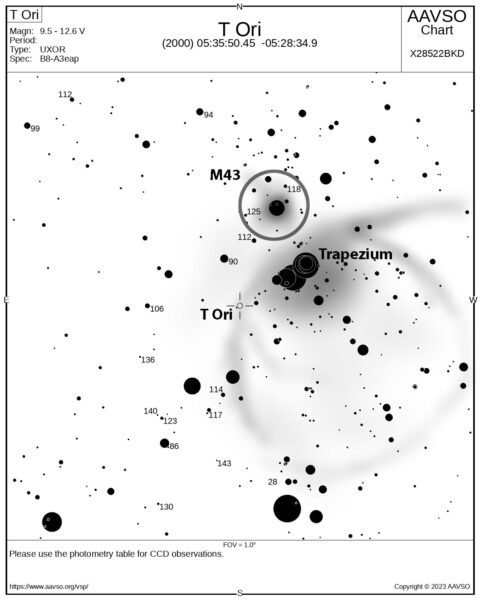
Courtesy AAVSO with additions by Bob King
Entangled in the luminous haze of the great nebula's eastern tendril, T Ori typically shines around magnitude 10.5, bright enough to observe in a 3-inch telescope. But unlike couch potato stars like our Sun, it chaotically bounces up and down between magnitudes 9.5 and 12.6. In just the past two weeks (February 1–14) I've seen it vary between 10.5 and 10.0, a difference in brightness readily apparent to the eye when compared with nearby stars of known brightness. To aid in seeing the fluctuations I use the free charts from the American Association of Variable Star Observers(AAVSO). Go to the website, type in the star name in the Pick a Star box, and then select Create a Finder Chart. Charts are available at various scales from wide to narrow fields of view.
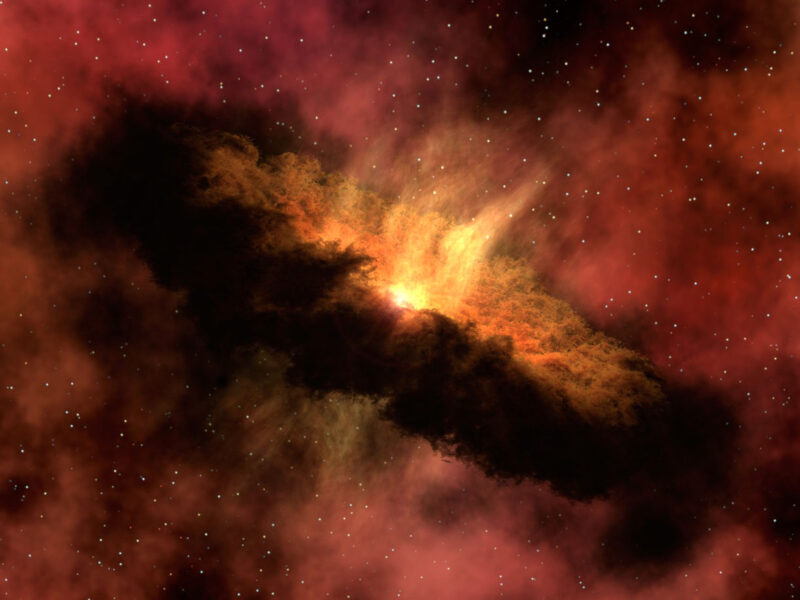
NASA/JPL-Caltech/R. Hurt (SSC/Caltech)
Unlike the cyclic variations of Mira stars or the near-clockwork period of Algol-type eclipsing variables, T Ori is all over the place like an unsupervised two-year-old. Still surrounded by a dusty, clumpy protoplanetary disk, the brightness of T Ori varies depending on what passes through our line of sight. Variations in the density of the dust (thick or thin) as it whirls about the infant star cause it to erratically fade and brighten much like fast-moving clouds on a windy day cover and uncover the Sun. Newly forming planets or swarms of comets also alter the texture and opacity of the disk. In a very real sense, the flickers of T Ori reflect the evolution of its remaining birth cloud into a solar system that may one day boast hot Jupiters, super-Earths, and even terrestrial-like planets.
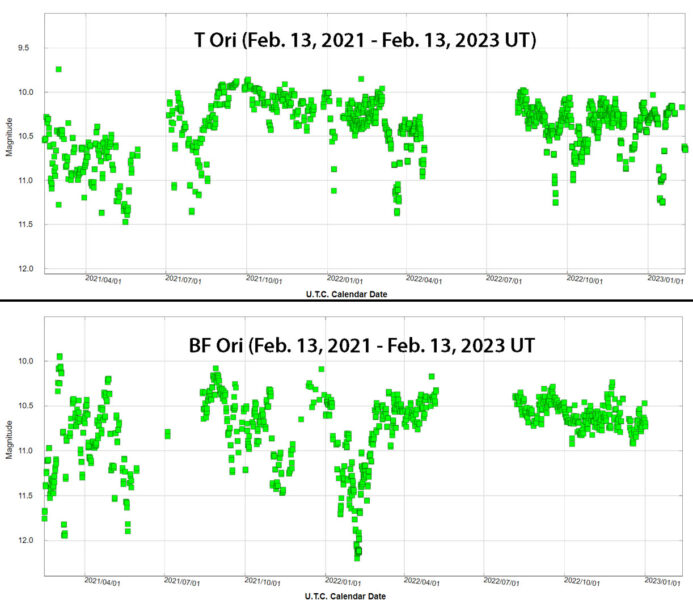
Courtesy AAVSO
T Ori belongs to the UX Orionis class of variable stars (UXORs) that typically shine at maximum brightness but undergo sudden and unpredictable periods of fading. These young hotshots fuse deuterium until they accrete enough matter to initiate hydrogen burning and hold down a job on the main sequence. They're typically less than 10 million years old and from two to ten times as massive as the Sun. UXORs are also classified as Herbig Ae/Be stars, pre-main-sequence stars of spectral types A and B, first described by American astronomer George Herbig in a 1960 paper. They're similar to T Tauri stars but are larger and hotter. Our Sun is thought to have passed through the T Tauri stage 4.5 billion years ago as it contracted, heated, and and finally boarded the fusion train.
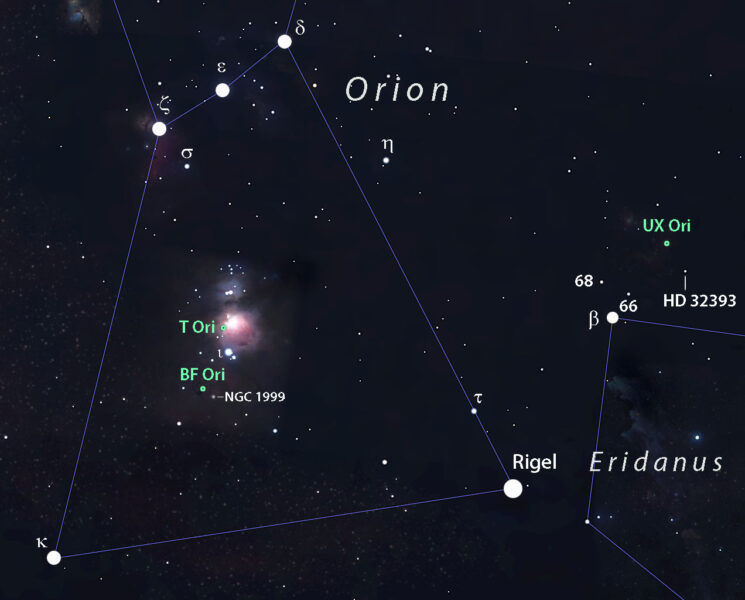
Stellarium
Given their youth, it's not surprising we'd find Herbig Ae/Be stars like T Ori in and near the Orion Nebula, the closest, large star-forming region to Earth. Astronomers have identified about 700 newborn suns in various stages of evolution cradled within its curdled nebulosity. Many display disks of dark dust especially when viewed in near-infrared light. Not far from the famous nebula — and just 15′ northeast of the bright reflection nebula NGC 1999 — you'll also find BF Ori, which varies dramatically and irregularly from magnitude 9.6 to 13.5. As I write, it's biding its time at magnitude 10.1, but who knows what it will be tonight. I've seen it dramatically fade more than a few times, and I can tell you, it's very exciting. Forget the Super Bowl. I'd much rather be watching the stellar evolution game.
Finally, we arrive at UX Ori, the UXOR prototype, which varies from magnitude 9.4 to 12.7, a range covered by a 6-inch telescope. Located 1.5° northwest of 3rd-magnitude Beta (β) Eridani, it's currently about magnitude 10.3 (February 13th), but as recently as early January it had sunk to 11.8!
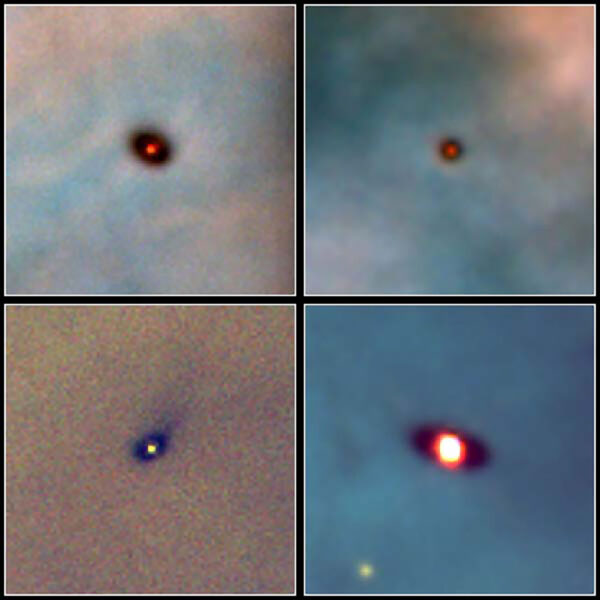
Mark McCaughrean (Max-Planck-Institute for Astronomy), C. Robert O’Dell (Rice University), and NASA
A word of advice about these unpredictable adolescents. Unlike other night-sky targets, they require patience and low expectations. Making frequent visits is key. The more often you drop by to check on a star's brightness, the faster you'll find it and the greater likelihood of catching those magic moments when it fades or rebrightens. I can knock off all three in a matter of minutes before moving on to more picturesque comets, nebulae, and planets. Later, I'll submit my magnitude estimates to the AAVSO which uses the data to better model the behavior of this important group of stars. You can share your observations, too, by getting a free AAVSO account.
During your regular checks on UX, T, and BF Ori, imagine all of the sorting out that has to happen as gravity and magnetism fashion their new solar systems from interstellar grit and gas. More amazing, these fits and starts are visible in even the smallest telescopes.
Quelle: Sky&Telescope
